Head to any coral reef, on any continent, in any part of the world, and you’d be hard-pressed not to spot a butterflyfish (Chaetodontidae). These cute and colourful marine creatures appear in their droves among the atolls of underwater reef systems, delighting scuba divers with their seemingly endless array of shapes, sizes, patterns, and colours.
Butterflyfish may not be the largest animals in our oceans by any stretch of the imagination, but they are without doubt always a joy to see – much like the insects from which they take their name. So, to celebrate these beautiful but often overlooked creatures, we’re taking an in-depth look at the humble butterflyfish in all its colour and splendour.
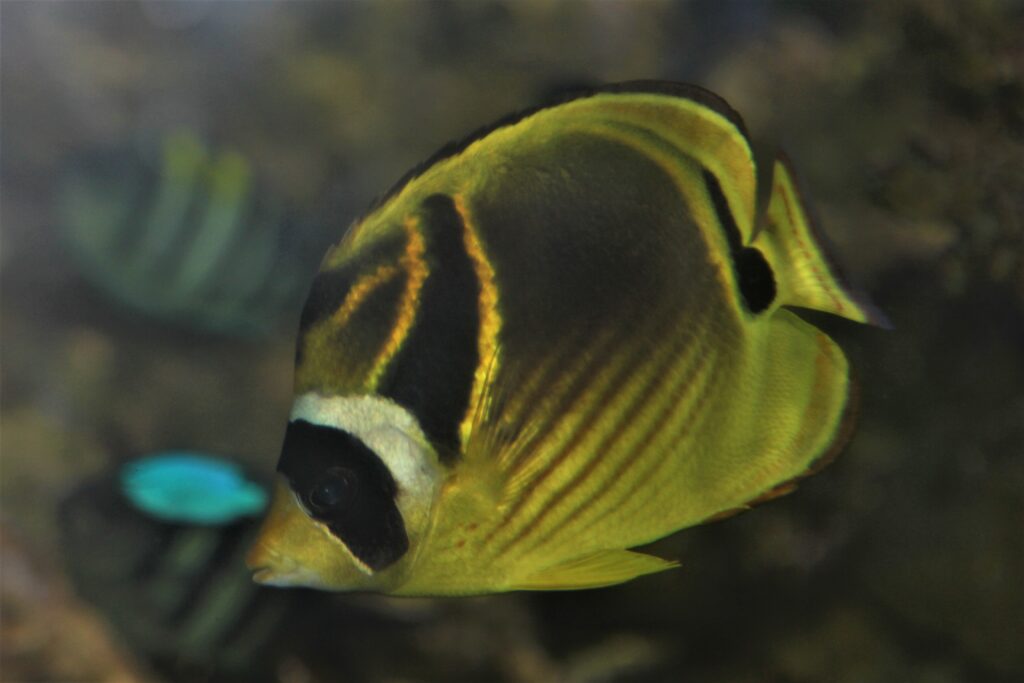
Your need-to-know butterflyfish fact file
First things first, let’s help you get to know the butterflyfish a little better. Here’s everything you need to know about these fun and docile creatures of the deep.
How big are butterflyfish and what do they look like?
Butterflyfish are classified as small fish and rarely grow bigger than 20cm in length. Similar to the angelfish, they have flattened bodies which allow them to manoeuvre easily through passages in coral reef systems.
Of course, one of the most notable features of butterflyfish is their brightly coloured bodies. Thanks to these distinctive colours and patterns, butterflyfish are able to camouflage themselves among the coral, keeping them out of sight whenever a predator passes by. Some of the most common butterflyfish fish colour variations include black, yellow, and white.
Other distinctive features of the butterflyfish include their uninterrupted dorsal fins and round tails, as well as their attractive disk-shaped bodies. Essentially, you’ll spot one a mile off – unless they’re well camouflaged, that is. Many butterflyfish also have a false eye on the back of their body, so predators think they’re staring right at them! Paired with the blackout of their actual eyes, and this makes a super confusing trick.
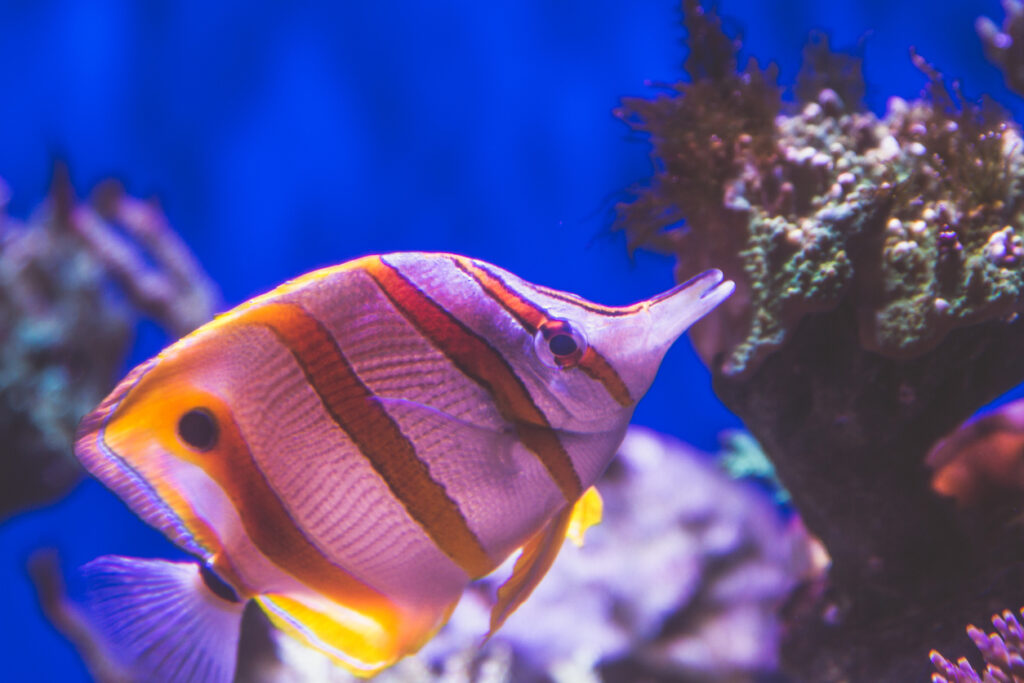
Where are butterflyfish commonly found?
That’s easy: pretty much everywhere!
Butterflyfish are found throughout the world’s oceans, particularly in tropical waters where their beloved coral reef habitats are found in abundance. They have been sighted in the Atlantic, Indian, and Pacific oceans, placing them among the most widespread species of tropical fish on the planet.
How many species of butterflyfish are there?
Marine biologists place the number of butterflyfish species at around 129, though there may be more yet to be discovered. Since butterflyfish are able to change their colour to blend into the background, it’s sometimes hard to pinpoint specific species, so there could well be other types of butterflyfish out there that biologists are yet to classify.
What do butterflyfish eat?
Like their insect counterparts, butterflyfish have a surprisingly varied diet. While their preferred food is small invertebrates like worms and sponges, they’re also known to eat plankton, algae, and coral polyps. Whatever’s on the menu, butterflyfish have the right tools for the job, with a protruding mouth and comb-like teeth that allow them to feed in the tiny crevices and gaps of coral reef systems. The copperband butterflyfish even munches on pest anemone, thanks to their mucous-y lips which stops them from being stung!
What are a butterflyfish’s most feared predators?
Butterflyfish have a lot to contend with down on the reef, so no wonder they prefer to stay hidden in the coral. Their natural predators include the fearsome moray eel, snappers, groupers, and sharks. Sadly, they’re virtually defenceless, so their only option is to swim and hide if detected by a predator.
Bonus fast facts about the amazing butterflyfish
- Remarkably, butterflyfish communicate by sound and can often be seen swimming in pairs as a result of this. The fish work together while feeding, with one essentially keeping a lookout for approaching predators.
- Some species of butterflyfish have an eye-like pattern on their tails, which they use to confuse would-be predators.
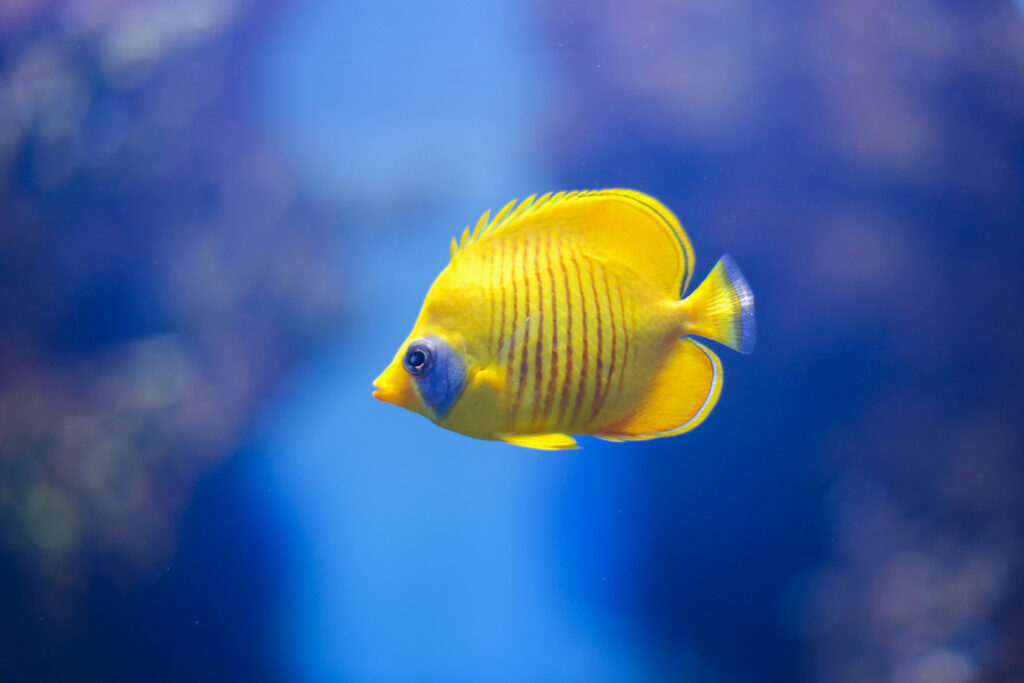
What are the most notable species of butterflyfish?
With a minimum of 129 species of butterflyfish in our oceans, it’s difficult to choose favourites. But for the sake of showcasing just how beautiful and varied these tropical reef fishes are, we’ve picked out a handful that offer something extra special.
African butterflyfish (Pantodon buchholzi)
First up is perhaps the most unusual butterflyfish of them all: the African butterflyfish. These curious creatures reside in freshwater as opposed to the ocean and aren’t closely related to their seafaring brethren. Still, they’re no less charming, with a unique body shape and spectacular pectoral fins that let them glide effortlessly through the water.
Copperband butterflyfish (Chelmon rostratus)
With its exquisite copper and white markings and slender, protruding mouth, the copperband butterflyfish is a classic example of the species. These fish are predominantly white, with three brightly coloured bands running the length of their bodies from top to bottom. They’re typically found in the western Pacific, among the exquisite corals of the Great Barrier Reef.
Threadfin butterflyfish (Chaetodon auriga)
With a distinctly patterned body that’s not unlike a pop star from the 1980s, the threadfin butterflyfish is a joy to look at. These unique fish are black, white, and yellow in colour, with narrow diagonal stripes interlocking across their bodies. You’ll find them all over the world, from the Red Sea to Hawaii.
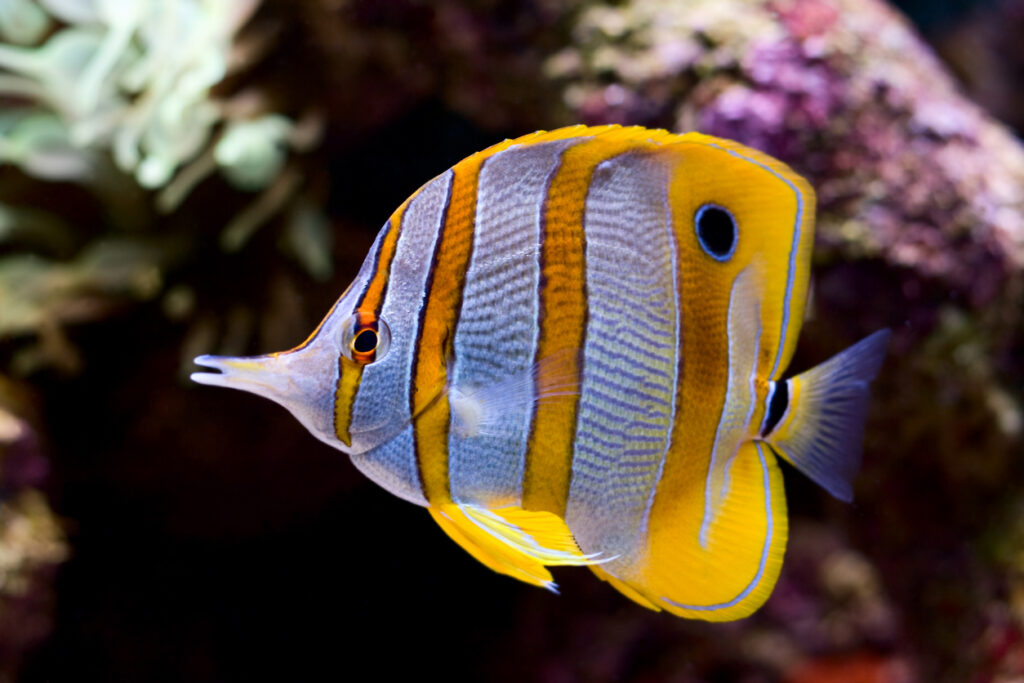
Longnose butterflyfish (Forcipiger flavissimus)
You guessed it, the longnose butterflyfish has one highly distinctive characteristic: a gigantic snout! The longnose’s nose measures virtually a third of its total body length, perfect for getting into tiny gaps to sniff out prey. It’s also extremely brightly coloured, with a vibrant yellow body that’s topped with a mohawk-like dorsal fin. Trust us, this butterflyfish is hard to miss.
Pearlscale butterflyfish (Chaetodon xanthurus)
Arguably the prettiest of all butterflyfish species, the pearlscale butterflyfish is characterised by its iridescent scales that shimmer in the sunlight beneath the waves. While most of their bodies are silver, their tails are striped in the colours of white and orange, much like a clownfish. This is a defence mechanism intended to confuse predators, which can easily miss their target, allowing the pearlscale to swim away unscathed.
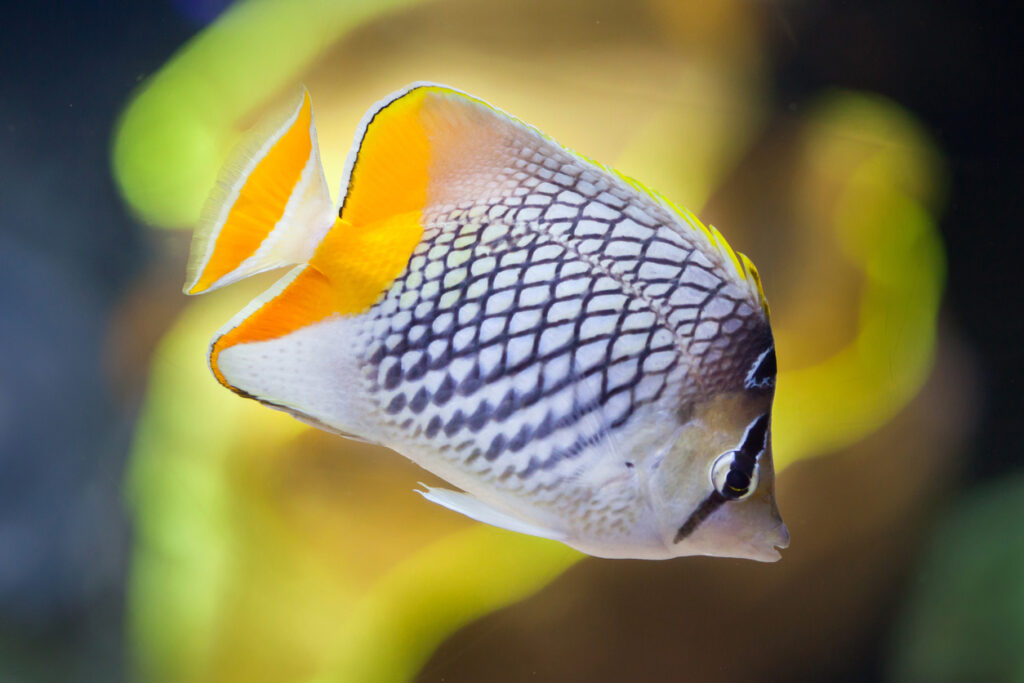
Lunula raccoon butterflyfish (Chaetodon lunula)
Thanks to its adorable black and white eye markings, it’s very easy to see why this particular butterflyfish species earned its name. Found in the Indian and Pacific oceans, the racoon butterflyfish is on the larger side of the Chaetodontidae family, with a robust, oval-shaped body that can grow to over eight inches in diameter. Suffice to say, thanks to its size, markings and beautiful black, white, and yellow colour, this is a firm favourite
Schooling Bannerfish Butterfly (Heniochus diphreutes)
The schooling bannerfish is a species of ray-finned butterflyfish that’s native to the tropical waters of the Indo-Pacific. Measuring up to 21cm, the fish is often wrongly confused with the moorish idol, earning it the apt synonym false moorish idol. That’s all to do with its outlandishly long dorsal fin, which is longer than the fish’s actual body, as well as its striped body and brightly coloured pectoral fin.
Sunburst Butterflyfish (Chaetodon kleinii)
The coral-eating sunburst butterflyfish is identified by its unique black stripe, running near vertically through the centre of its head. These small golden fish typically live in deeper lagoons, where they often live in pairs – particularly during breeding periods. Sunbursts are omnivores that feed on a range of foods, including algae, plankton, and coral polyps.
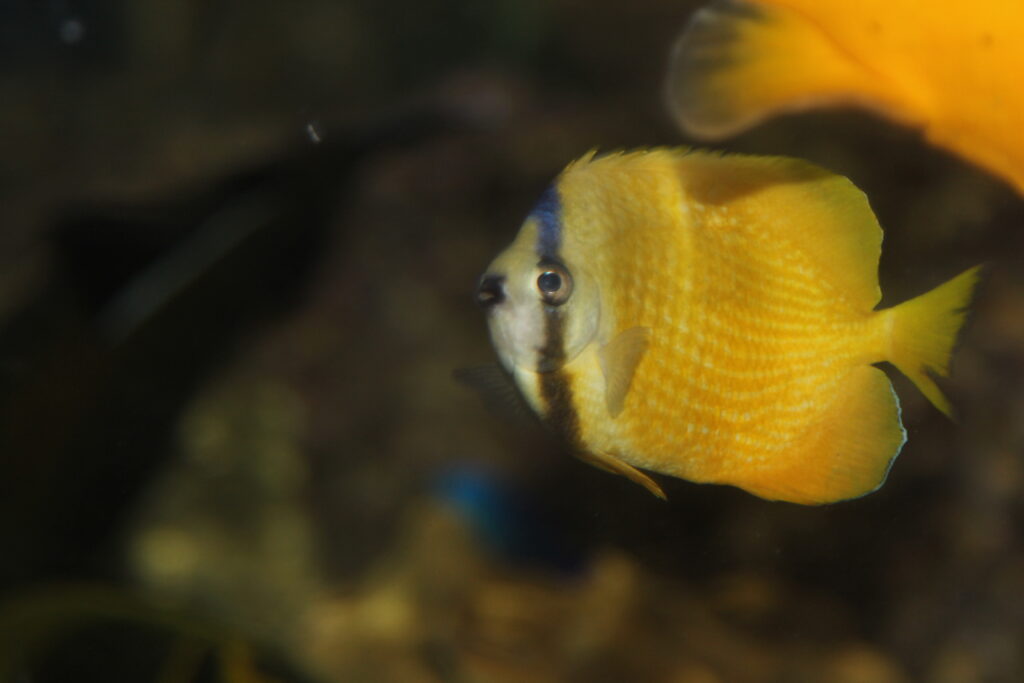
Pyramid butterflyfish (Chaetodon polylepis)
What better butterflyfish to end on than the pyramid, whose triangular markings prove that these fish really do come in all sorts of different shapes and patterns. The pyramid butterflyfish features a bold white shape that spans much of its body, as well as bright yellow fins at the top and bottom of its body. Unlike the racoon, this butterflyfish is on the smaller side, but its iconic triangular markings ensure it’s still easy to spot among its counterparts.
So, there you have it, an in-depth look at the irresistible butterflyfish. If you love tropical species like this, you’ll find plenty to enjoy over at Coral Cave, a special exhibit dedicated to the tropical fish of the Indian and Pacific oceans. To plan your next visit to Blue Planet Aquarium, check out our visitor info page.
